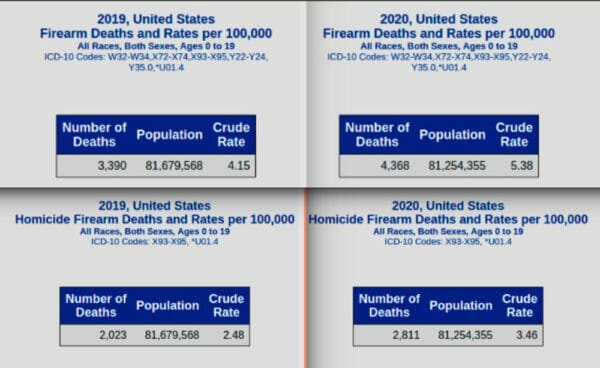
U.S.A. –-(AmmoLand.com)-— On April 23, 2022, Spectrumnews1.com published an article by Ryan Chatelain about a letter to the New England Journal of Medicine (NEJM).
The letter was about the increase in firearm-related deaths among young people aged 0-19. There was a significant increase in 2020 over 2019. Few Americans would be surprised by this, as the increase in homicides, especially in urban centers among young minority adults, is well known. In a peculiar twist, Chatelain attributes the cause of the deaths to firearms.
This was a significant change from the original letter to the NEJM.
From spectrumnews1.com:
Firearms have surpassed automobiles as the leading cause of death among children and adolescents in the United States, researchers at the University of Michigan say.
The letter to the NEJM contained the peculiar grouping of young adults 18-19 as “children and adolescents”. It was careful not to claim that firearms were the cause of the deaths.
From nejm.com, letter to the editor:
The previous analysis, which examined data through 2016, showed that firearm-related injuries were second only to motor vehicle crashes (both traffic-related and nontraffic-related) as the leading cause of death among children and adolescents, defined as persons 1 to 19 years of age.4 Since 2016, that gap has narrowed, and in 2020, firearm-related injuries became the leading cause of death in that age group (Figure 1).
(snip)
Although the new data are consistent with other evidence that firearm violence has increased during the Covid-19 pandemic,5 the reasons for the increase are unclear, and it cannot be assumed that firearm-related mortality will later revert to prepandemic levels. Regardless, the increasing firearm-related mortality reflects a longer-term trend and shows that we continue to fail to protect our youth from a preventable cause of death.
There are two important differences between the Spectrumnews article and the NEJM letter.
- First, the NEJM letter correctly uses the terms “firearm-related injuries” and “motor vehicle crashes”, not firearms and automobiles.
- Second, the NEJM letter states “the reasons for the increase are unclear”. The Spectrum article implies the reasons are clear: firearms.
The NEJM letter states the increase in firearm-related mortality among people aged 1-19, from 2019 to 2020, was 29.5%.
The increase in national firearm numbers from 2019 to 2020 was from about 441 million to about 462 million, an increase of about 5%. It is difficult to believe a 5% increase in firearms resulted in a 29.5% increase in firearm-related mortality.
Increases in the number of firearms have not correlated with increases in the number of firearms-related deaths, particularly firearms-related homicides, which make up over 80% of the increase noted above.
Why the research cited in the NEJM letter defines “children and adolescents” as people below the age of 20, is uncertain. People 18 – 19 are considered young adults, not children. The World Health Organization (WHO) defines adolescents as somewhere between the ages of 10-19. The word is imprecise. Some people are considered adolescents up to 24 years old. The NEJM reference research may be using an abbreviated WHO definition.
The legal definition of a child is less than 18 years old. It seems appropriate, as many firearms laws differentiate between legal adults and children.
Including 18 and 19-year-olds in the firearm-related death categories almost doubles the number of deaths, from 2,281 to 4,368.
If the firearm-related deaths are examined closely, it becomes obvious; that certain cultural groups have high homicide rates among young people. Other cultural groups have higher suicide rates among old people. Most of the homicides and suicides in both cultural groups are among males.
It is not clear that legal access to firearms increases or decreases either suicide or homicide in either group. What effects there may be are small and difficult to measure.
Cultural attitudes toward homicide and suicide appear to have large effects, which are easily measured.
Opinion:
To reduce homicide and suicide levels, the focus should be on education and attitudes, instead of firearms.
About Dean Weingarten:
Dean Weingarten has been a peace officer, a military officer, was on the University of Wisconsin Pistol Team for four years, and was first certified to teach firearms safety in 1973. He taught the Arizona concealed carry course for fifteen years until the goal of Constitutional Carry was attained. He has degrees in meteorology and mining engineering, and retired from the Department of Defense after a 30 year career in Army Research, Development, Testing, and Evaluation.

from https://ift.tt/iTzGHXw
via IFTTT

No comments:
Post a Comment